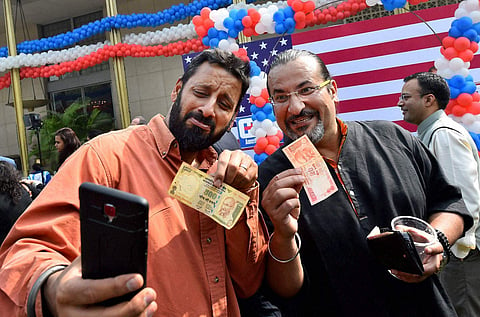

NEW DELHI: Economists believe the roots of the current slowdown besetting India were sown by the midnight announcement to demonetise some 86 per cent of India’s currency by value three years ago this day, though they also blame introduction of a flawed GST, the twin balance sheet crisis facing banks, the collapse of major NBFCs as well as an overall global slowdown for the current economic impasse.
Prof. Govinda Rao, former member of the Prime Minister’s Economic Advisory Council, said, “There were a number of factors besides demonetisation which hit the informal sector very hard… these included introduction of a new GST system of taxes with a lot of hiccups, a slowdown of the MSME sector, higher transaction costs etc., but demonetisation was the starting point.”
“Our system does not capture data from the unorganized sector easily, but with revisions of GDP figures we will see that there was a sharp drop after that incident,” said Rao. A study done by Gita Gopinath of IMF, Prachi Mishra of Goldman Sachs and others entitled 'Cash and the Economy: Evidence from India's Demonetisation', estimates there was a 2.2 per cent decline in economic activity in November and December 2016 and a 2-3 per cent reduction in jobs in the quarter after the note ban.
According to the Labour Bureau's Sixth Annual Employment-Unemployment Survey, the unemployment rate rose to a four-year high in 2016-17, when the government demonetised old currency notes. In 2017-18, the country's unemployment rate stood at a 45-year-high of 6.1 per cent, according to the latest National Sample Survey Office's (NSSO's) periodic labour force survey (PLFS).
“The fact is that the demonetisation compounded by the flawed introduction of GST and the NBFC crisis, besides an overall global slowdown has meant that the jobs lost ad demand slowdown which occurred as a fall-out of the note ban has not only not been reversed but continues,” said Prof. Arun Kumar, the Malcolm S. Adiseshiah Chair at the Institute of Social Sciences, New Delhi.
Added Madan Sabnavis, Chief Economist, Care Rating, “The two factors constraining the economy today are consumption and investment, and the genesis of this decline can be traced back to 2016. This was the year when there was a good harvest and the rural story played out in our favour. However, the small and medium enterprise (SME) sector, which is the largest employer, went down when the currency was withdrawn … this caused large scale job losses and closure of units.”
The packages announced by the government are addressed at the corporate sector but do not repair the demand slowdown which has its roots in the crisis in the unorganised sector, Kumar points out. The government has till now slashed corporate taxes and come out with sector-specific packages such as for banking, automobile and realty, while the RBI has cut interest rates.
However, these measures have not helped to halt the downtrend till now. Industrial output growth in August contracted by 1.1 per cent and the output of eight core infrastructure industries contracted by 5.2 per cent in September. The RBI cut its economic growth forecast for FY20 by 80 basis points to 6.1 per cent from the projection it made in the August policy meeting.
“Both investment and consumption are declining and that is alarming,” said Prof. Rao. A recent National Sample Survey for consumer demand in urban and rural areas clearly showed that compared to 2014-15, demand had slowed down in 2017-18, while a report released last month by state-run SIDBI and credit agency TransUnion CIBIL showed commercial credit demand contracted 2.6 percentage points to Rs 63.80 lakh crore in the June quarter over the three months to March period.